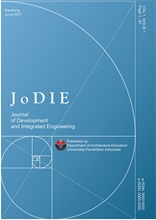AESTHETIC VALUES OF RUINS: A CASE STUDY OF THE MALABAR RADIO STATION AREA
Abstract
Relics of the past that have historical value must be preserved, but due to war and natural factors, these relics only leave ruins, so the conservation measures are different from buildings. The aesthetic value is one of the reasons for maintaining the ruins as they are, where this value is related to the physical and non-physical aspects of the ruins. One of the locations of the historical ruins is the ruins in the Malabar Radio Transmitting Station Area located on Mount Puntang, Banjaran District, Bandung Regency, West Java, which used to be a Radio Station complex that bridged long-distance communications between Indonesia and the Netherlands, has important historical value and impact the time. A change in function to become a tourist spot at this location can intervene in the ruins by adding or developing tourist facilities that can reduce or damage their historical and aesthetic values. This study intends to examine the aesthetic value of the ruins of the Malabar Radio Station to find a value that can be maintained as it is. This research uses qualitative research methods by searching historical data through primary and secondary sources. The results of the study found that the aesthetic value of the ruins consisted of 1) physical aesthetic values related to the shape of the ruins that can be observed and felt with the five senses, identified forms and materials (traces of weathering, the remaining walls, and floors) that blend into the mountainous landscape to give it an interesting and distinctive landscape character and visual appeal; and 2) non-physical aesthetic value related to the function of marking the passage of time, evidence of representation of the involvement of indigenous workers, defense of independence in the Banjaran region, and becoming a tourist attraction. Both of these aesthetic values are things that must be protected and maintained for the preservation of the ruins.
Full Text:
PDFReferences
Agung, L. (2017). Aesthetics: Introduction, History and Concepts (G. Sudibyo (ed.)). PT KANISIUS.
Akihary, H., Purwestri, N., & van Roosmalen, PKM (2016). Digging4Data (Finding Data). Cultural Heritage Agency of the Netherlands (RCE), Amersfoort.
Ali, M. (2011). Aesthetics: An Introduction to the Philosophy of Art. Luxor Studio.
Ashurst, J. (2007). Conservation of Ruins (First Edit). Elsevier.
Australia ICOMOS. (1999). The Burra Charter : the Australian ICOMOS charter for places of cultural significance 1999 : with associated guidelines and code on the ethics of co-existence. International Council on Monuments and Sites, 23.
Brundage, A. (2018). Going to The Sources: A Guide to Historical Research and Writing (6th ed.). John Wiley & Sons. Inc.
Camocini, B., & Nosova, O. (2017). A second life for Contemporary Ruins. Temporary Adaptive Reuse strategies of Interior Design to reinterpret vacant spaces. Design Journal, 20(sup1), S1558–S1565. https://doi.org/10.1080/14606925.2017.1352680
Charlesworth, E. (2006). Architects Without Frontiers: War, Reconstruction and Design Responsibility (1st ed.). Elsevier.
Dijkstra, K., & Arthur O. Bauer. (2006). Radio Malabar: Herinneringen aan een boeiende tijd 1914 - 1945. Emmaus, Groenlo.
Djikstra, K. (n.d.). Radio Malabar: Herinneringen aan een 30-jarige radioloopbaan (Deel 2: de kortegolf period).
Ginsberg, R. (2004). The Aesthetics of Ruins. Rodopi. https://doi.org/10.1080/10464883.2018.1410650
Groat, LN, & Wang, D. (2013). Architectural Research Method (Second Edi). John Wiley & Sons. Inc.
Hill, J. (2019). The Architecture of Ruins: Designs on the Past, Present and Future. In The Architecture of Ruins. Routledge. https://doi.org/10.4324/9780429429644
Katam, S. (2013). Tjitaroemplein Bandung: from the Post Office, Radio Malabar Monument, to the Istiqamah Mosque (1st ed.).
Leenders, B. (2013). Dieben, Willem Frederik Christiaan (1886-1944). https://resources.huygens.knaw.nl/bwn1880-2000/lemmata/bwn5/diepen_w
Moleong, LJ (2006). Qualitative Research Methods (22nd ed.). PT. Rosdakarya youth.
Pallasmaa, J. (2009). Space, Place, Memory and Imagination: The Temporal Dimension of Existential Place. In M. Treib (Ed.), Spatial Recall: Memory in Architecture and Landscape (pp. 16–41). Routledge.
Law of the Republic of Indonesia No. 11 About Cultural Conservation, Pub. L.No. 11, 1 (2010). https://peraturan.bpk.go.id/Home/Details/38552/uu-no-11-tahun-2010
Permana, A. Y., Akbardin, J., & Nurrahman, H. (2020). Development of Urban Space Based on Student Migrants in Bandung City, Indonesia. Journal of Physics: Conference Series, 1625(1). https://doi.org/10.1088/1742-6596/1625/1/012003
Ryynänen, M., & Somhegyi, Z. (2018). Learning from Decay: Essays on the Aesthetics of Architectural Dereliction and Its Consumption. Peter Lang. https://doi.org/10.3726/b13245
Sunarto. (2020). Philosophical Aesthetics (1st ed.). Lontar Mediatama Yogyakarta.
Udo, J. -W. (2018a). Communicatie in de coloniale tijd. https://radiokootwijk.nu/geschiedenis-malabar/radiocommunicatie-in-de-koloniale-tijd-een-nieuwe-weg-naar-indie/
Udo, J. -W. (2018b). Radiocommunicatie in Indië: Een stukje Geschiedenis van het Radiozendstation Malabar (Bandung). https://radiokootwijk.nu/geschiedenis-malabar/
Udo, J. -W. (2018c). Radiozendstation in de Malabar 1917 – 1947. https://radiokootwijk.nu/geschiedenis-malabar/bandoeng-2/
Whitehouse, T. (2018). How ruins acquire Aesthetic value: Modern ruins, ruin porn, and the ruin tradition. In How Ruins Acquire Aesthetic Value: Modern Ruins, Ruin Porn, and the Ruin Tradition. Palgrave Macmillan. https://doi.org/10.1007/978-3-030-03065-0
DOI: https://doi.org/10.17509/jodie.v2i2.67792
Refbacks
- There are currently no refbacks.
Copyright (c) 2024 Rahmadean Alifani Purwatiana, Sri Handayani

This work is licensed under a Creative Commons Attribution-NonCommercial-ShareAlike 4.0 International License.

This work is licensed under a Creative Commons Attribution-ShareAlike 4.0 International License. Statcounter








